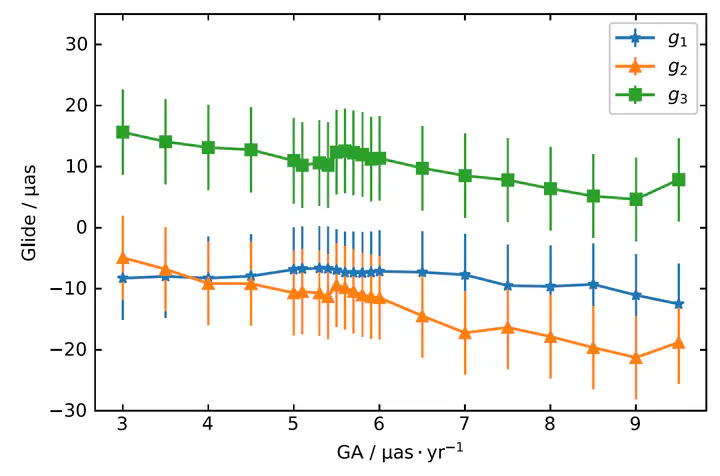 Schematic of GA-induced proper-motion field and its reference-frame implications (Liu & Liu 2020, Chin. Astron. Astrophys. 44, 131–145)
Schematic of GA-induced proper-motion field and its reference-frame implications (Liu & Liu 2020, Chin. Astron. Astrophys. 44, 131–145)Abstract
The Galactic aberration (a.k.a. secular aberration drift) arises from the centripetal acceleration of the Solar System Barycenter around the Galactic center. It induces distance-independent apparent proper motions of extragalactic sources with an amplitude of ~5 μas yr⁻¹, producing a slow global spin and small regional distortions of celestial reference frames. Using vector spherical harmonics, the proper-motion field is characterized by dipolar (spheroidal) terms, and its impact propagates to Earth Orientation Parameters (EOP), requiring ~1 μas yr⁻¹ corrections to precession rates over decades. For high-precision realizations (VLBI ICRF3 and Gaia optical frames), the GA must be modeled to ensure a rigid, non-rotating link between radio and optical reference frames.
Galactic aberration (GA) is the apparent proper-motion field caused by the Solar System
Barycenter’s acceleration toward the Galactic center. With amplitude (g \approx 5~\mu\mathrm{asyr^{-1}}),
the field drives a slow global spin of the realized reference frame depending on source distribution,
and introduces small but accumulating systematics in EOP (e.g., (\sim 1\mu\mathrm{as~yr^{-1}}) in precession rates).
In the ICRF3–Gaia era, modeling GA—together with frame-rotation terms—is essential for a rigid radio–optical link.
Key formulas include the VSH description of the dipolar field and closed-form expressions for GA-induced
proper motions and frame rotation. :contentReference[oaicite:0]{index=0}
Citation:
Liu, J.-C., & Liu, N. (2020). The Galactic Aberration and Its Impact on Astronomical Reference Frames.
Chinese Astronomy and Astrophysics, 44, 131–145.
https://doi.org/10.1016/j.chinastron.2020.05.001